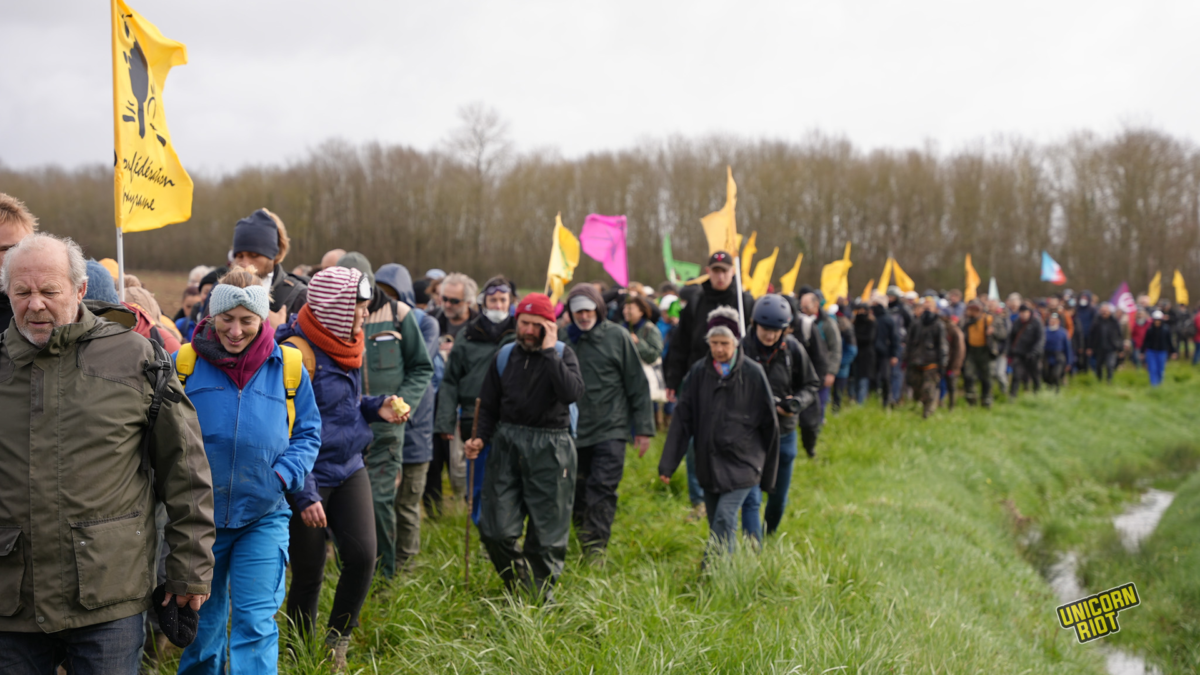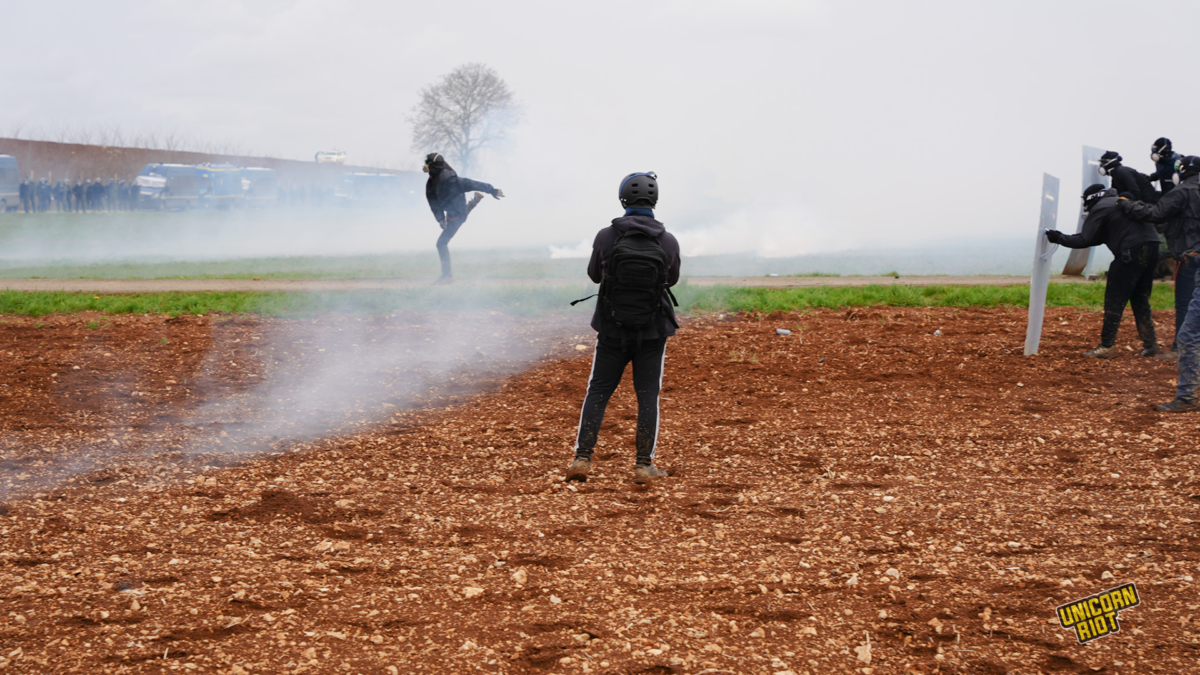The Battle of Sainte-Soline
Over 30,000 protesters battled thousands of police in rural France over construction of mega-basins.
Sainte-Soline, France — It is a Saturday morning deep in rural western France. Tens of thousands of activists, organized in different marches, left a self-managed protest camp next to the idyllic village of Vanzay. They headed toward the construction site of a water reservoir, dubbed “mega-basin,” in Sainte-Soline in the Department of Deux-Sèvres between the cities Nantes, Poitier and Bordeaux. At the very front of the first march a large wooden structure in the shape of a bird is carried by dozens of people accompanied by Greek Sirtaki music coming out of a mobile sound system. In another march, thousands are marching in blue boiler suits equipped with breathing masks, swimming goggles and self-made protective shields. People cry the unusual slogan “No Bassaran!” — an adaptation of the familiar antifascist slogan “No Passaran!”
When the marches are about to reach their destination, police promptly shoot hundreds of tear gas grenades at the protesters. Undeterred, marchers slowly surround the reservoir area, which has been transformed into a fortress. Police vans, 3,000 units of gendarmerie and riot police, four wheelers, a water cannon and armored vehicles are awaiting the protesters. (Gendarmerie are similar to the U.S. National Guard in policing mode.)
An epic battle breaks out between activists and police. The activists, after multiple attempts, do not manage to enter the area but five police cars are burned down.
During the battle, police used a total of 4,000 tear gas and stun grenades, causing serious injuries — two activists were in a coma for days after the weekend. In total, 200 people were injured, according to the protesters paramedics. One of them is known as Serge AKA ‘Comrade S.’ — The parents of ‘S.’ announced on April 26 that he came out of the coma but is still in critical condition, a month after the protest. Protesters say that authorities even blocked and delayed the access of emergency medics to treat the injured. A press release from ‘Comrades of S’ stated:
“On Saturday 26 March in Sainte-Soline, our comrade S. was hit in the head by an explosive grenade during the demonstration against the basins. In spite of his state of absolute emergency, the prefecture knowingly prevented the emergency services from intervening in the first place, and from transporting him to an appropriate care unit in the second place. He is currently in neurosurgical intensive care. His vital prognosis is still in danger.”
“Comrades of S” press release
According to the organizers, 30,000 people participated in the protests. Farmers and activists from all over France took part, with left-wing unions such as CGT and Sud Solidaires at the forefront. An international delegation was also present, such as Manuela Royo from the environmental movement MODATIMA in Chile and Juan Pablo Gutierrez, a delegate of the Yukpa indigenous people from Colombia. Present were also numerous parliamentarians such as Clémence Guetté from the French left group NUPES.
The battle of Sainte-Soline prompted a wide discussion in the French public about the heavy repression on one side and the accusations of so-called “ecoterrorism” from the state towards the protesters on the other side.

Why Protest Against Mega-Basins?
At the site of Sainte-Soline between La Rochelle and Poitiers, the second of 16 planned water reservoirs is under construction. The open crater, as big as ten soccer fields, which is to be lined with plastic, can store up to 650,000 cubic meters of water — about 260 Olympic swimming pools — pumped from underground during winter to irrigate corn fields in summer. The reservoirs are filled from the water table and aquifers during the winter for farmers to use during the spring and summer growing seasons. According to critics, water is already scarce in this region, even in winter.
In theory, mega-basins reduce the strain on aquifers during increasing summer droughts. But contrary to what their proponents would have the public believe, mega-basins are not simply fed by rainwater. The water must be pumped from groundwater or rivers. Even if pumping occurs in winter, it increases pressure on water resources. By storing water that would otherwise seep into the ground or flow into rivers, they deprive surrounding ecosystems of a vital resource that regenerates during the winter months. Critics say the water is only available to the participating farmers who are part of the “capitalist agroindustrial business.” Wealthy landowners and businessmen privatize water for the intensive irrigation of their crops.
Water diverted for private interests will also be missed by the neighboring Marais Poitevin nature park, endangering its wetlands. Of the project’s estimated 60 million euro budget, 70% is being financed by public funds.
For more on the ‘mega-basin’ protests, check out our previous report here
Last summer saw the worst drought in French history, which exacerbated the debate over water resources. Around 2,000 municipalities in France suffered from a water shortage. Nearly half of them had to have bottled water or water delivered by tankers. Water consumption is currently restricted in 15 of 96 departments (province-like units within Metropolitan France, aka the mainland and Corsica). For example, no cars may be washed or lawns watered. In the south of the country, some mayors have already refused building permits for private pools.

Weapons of Repression
The battle of Sainte-Soline featured an extensive level of police repression – many witnesses describe it as a “real war scenario.” In the days before the protest, police checkpoints and identity controls of individuals and their cars were a daily routine for many of the activists and local residents. Any protest gathering was forbidden by the local authorities who established a large ‘red zone’ around Sainte-Soline.
On the day of the big protest, the police waited at the construction site for the protest marches to arrive and held their position by using a range of weapons and vehicles. Dozens of special riot police were riding across the vast field in four wheelers. The biggest part of the gendarmerie and police forces were standing at their vans forming a protective wall around the construction site. They made copious use of so-called ‘less-lethal’ weapons such as tear gas and stun grenades. Most of the protesters had no appropriate protective gear to match this use of force and material.
After the second and third march arrived at the basin, harder munitions were used by the police. The gendarmes threw GM2L type explosive grenades, which also release tear gas and contain about 50 grams of the explosive RDX, which is 1.6 times more powerful than TNT and is supposed to “stun” people when detonated. The detonation of a GM2L grenade exceeds 165 decibels. At five meters, it surpasses the noise of an airplane taking off, well above the threshold for sonic pain and potential hearing damage.
In 2014, 21-year-old environmental activist and biologist Rémi Fraisse was killed by a similar grenade, and in 2018, a hand was blown off from a student of the same age, Maxime Peugeot, by a successor model. A total of seven other peoples’ hands were blown off by French police using such grenades during the “Yellow Vests” movement (2018) and other protests. Injuries are also caused by the loud banging or splinters flying around.
According to an initial assessment by medical teams, one person lost the use of his foot after suffering damage from police violence during the protest. There were also numerous disfiguring wounds on the faces of the demonstrators and hematomas on the eyes that could lead to blindness, shrapnel in the calves, thighs or arms with the loss of pieces of flesh, burns on the legs, necrosis on the buttocks, wounds on the testicles, gastric pain and hearing damage.
A note from the intelligence service legitimizes the use of this type of weapon. It states that “the black blocs are only sensitive to GM2L grenades.” The shootings, coupled with the use of four wheelers, made it possible, according to them, to “defeat the demonstrators who would have retreated, weakened and diverted” towards the camp in Vanzay and the town of Melle, where the rear bases were located. The authors insist on the morale of the demonstrators as “psychologically tested” by the use of these weapons and praise the “victorious” strategy of the police forces, despite its terrible human consequences.
For the first time in France, a chemical product (PMC) was used to mark and later identify suspected violent demonstrators who could not be arrested directly at the demonstrations. For this purpose, a special rifle of the type EMF-100 is used to shoot a substance invisible to the naked eye at persons who can thus be identified with the help of UV lamps in the event of a later arrest, even many days later. With this marking technology, the police and gendarmerie in France expand their arsenal, which already includes highly controversial gases, grenades and hard rubber bullets that are classified as war weapons (category A2) in the Internal Security Code of France. The legal framework for PMC use is still unclear. Officially, it has been an “experiment” since 2019.
At least two people, including a freelance journalist, had been taken into custody for “participating in an assembly for the purpose of intentional violence and damage to property” and were held for 28 hours.
Background and Future of the Protests
Soulèvements de la Terre (SLT – Earth’s Uprisings) is a growing coalition: in the course of the last two years, an array of collectives and inhabitants formed throughout France. The SLT describe themselves as a “federation of struggling people, environmental associations, farms, naturalist groups, people’s kitchens, farmers’ unionists, rebellious scientists, trade unions, autonomous groups, popular education movements, elected representatives, and people of all ages and backgrounds.”
This alliance was initiated around a call written in Notre-Dame-des-Landes (NDL) in 2021. The ZAD (Zone to Defend) at NDL, near to Nantes, was an important symbol of resistance for the ecological movement in France because of the struggle against the building of an airport on ancient farmland.
The rise of SLT came about thanks to the pooling of experience and accumulated know-how. This feeds the hopes of those who have seen the dynamics of the autonomous and environmental movements neutralized as quickly as they emerged in the cycle of social and climate warfare that has been updated in recent years. It was under these circumstances that SLT emerged, promoting self-organization and the acceptance of offensive practices against “ecocidal capitalism.”
On March 28, two days after the violent battle, the Minister of the Interior, Gérald Darmanin, announced that he would initiate dissolution proceedings against SLT, which is seen as the cornerstone of the resistance to the Sainte-Soline mega-basins. The government wants to discredit the opponents of the water project as “eco-terrorists” and “ultra-leftists.” According to the minister the dissolution of SLT would be justified by the “unspeakable events” that occurred in Sainte-Soline and “the extreme violence of small groups that have been on file with the intelligence services, sometimes for very many years.” However, a confidential report from its own intelligence services on SLT sheds a completely different light on this announcement.
According to the French magazine Lundi Matin “on reading this surprisingly laudatory confidential note, one understands that beyond the displayed pretext of violence, if the minister seeks to dissolve the movement, it is because he succeeds!” Here some bits of the report:
“The SLT by their inventiveness, their level of organization, their strength of influence, their ability to mobilize and give national and media resonance to the local struggles with which they are associated, appear today as a major player in radical ecological protest.
Joining local struggles, selected by a centralized committee, SLT has been involved since its creation in about twenty actions in the framework of a program centered around the defense of ‘nourishing lands, the fight against ‘concretization’ and the protection of water, declined in different ‘Seasons’ and ‘Acts’ (the 4th season started in September 2022).
The SLT are also at the origin of the adoption of a new type of violent collective actions, inspired by those of the ultra-left: masked activists, wearing white or blue suits, forming a ‘White bloc’ or ‘Blue bloc’ not hesitating to confront the forces of law and order to commit their exactions (degradations, intrusions, sabotages…)”
Lundi Matin magazine
More than 50,000 people, including Nobel Prize in Literature winner Annie Ernaux, author Naomi Klein, trade unionists, artists, scientists, elected officials, and dozens of political, associative and trade union organizations in France and abroad, have affirmed their support for SLT movement by means of an appeal “We are the SLT” which was initially published in Le Monde.
The action in Sainte-Soline was part of the call for the so-called Season 5, which is to last until September. At the end of April, actions against the construction of highway A69 in the region of Toulouse are set to take place. The project would doom 400 hectares of farmland, wetlands, forests and other life forms: “An environmental disaster for a ridiculous gain in time.” In early May, the campaign will go up against the destruction of a wooded area in Rouen. In June, it goes south of the Loire river where the hills of Saint-Colomban are exposed to a double threat: extractivism for the benefit of the urban cities and land grabbing by the vegetable industry, without regard for the inhabitants and the farmers who keep the area alive.
A little later, in Maurienne, there is a protest against the tunnel planned to connect Lyon to Turin and is expected to draw thousands of international participants — especially from Italy. The TELT consortium (“Euralpin Tunnel Lyon Turin”) plans to complete a titanic railroad project with tunnels through the Alpine Massifs. Although freight transport has stagnated since the ’90s and the existing line is only used at 20% of its freight capacity, TELT plans to dig 11 tunnels, including the largest in Europe, the 57 km “Base Tunnel.”
While advocates of the tunnel project say it will serve as a “metro railway for Europe linking… ports, airports, intermodal hubs and even large urban centers,” organizers from “Earth Uprisings“ see the tunnel’s planned construction as merely “another way to save travelers and goods only 1 hour and 25 minutes between Paris and Milan. A simple way to ensure decades of juicy construction sites, propelled by more than 30 billion euros of public money.”
Organizations in France have been mobilizing already for ten years against the project. In Italy, the related historic NO TAV movement has been fighting for 30 years to preserve its valley, its mountains and the life that abounds there, despite continuous violent repression. (As reported in 2019 NoTav was also present in the political scene of Bologna.)
Unicorn Riot reporting on the French land defense struggle ZAD-NDDL:
- Sabotage and Civil Disobedience in France: The Fight Against Mega-Basins and Water Grabbing (November 20, 2022)
- ZAD Gathers to Rebuild as More Police Attacks Loom (April 15, 2018)
- A Report From the Frontlines of the ZAD-NDDL Eviction Attempt (April 12, 2018)
- ZAD Battles Thousands of Police During Attempted Eviction of Autonomous Zone in France (April 9, 2018)
- Greece: Networks of Resistance Pt. 1 – ZAD, Bure, Hambach Forest (August 10, 2017)
Follow us on X (aka Twitter), Facebook, YouTube, Vimeo, Instagram, Mastodon, Threads, BlueSky and Patreon.
Please consider a tax-deductible donation to help sustain our horizontally-organized, non-profit media organization:



